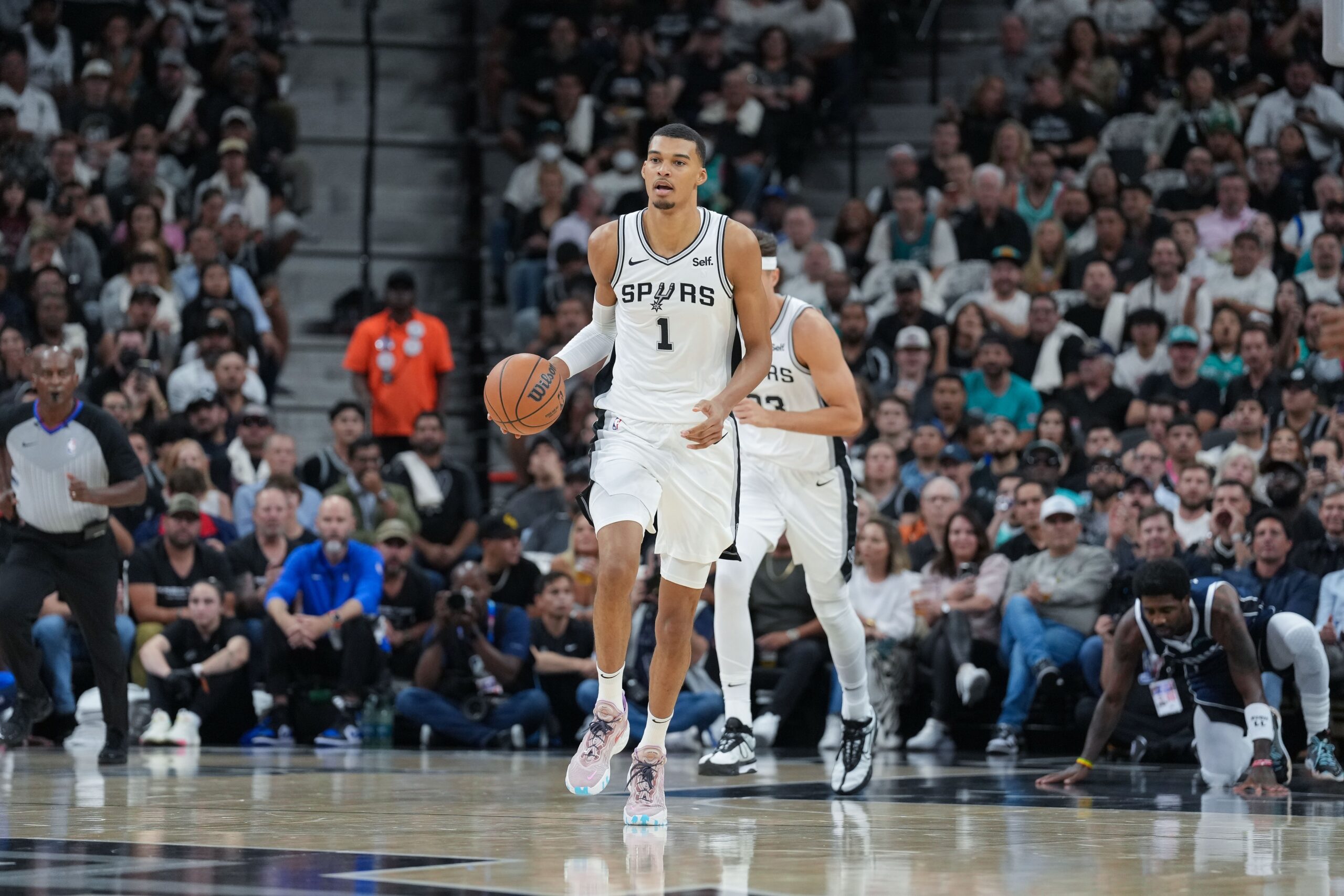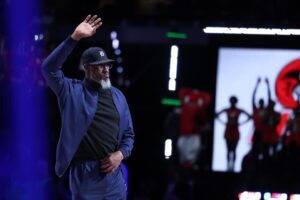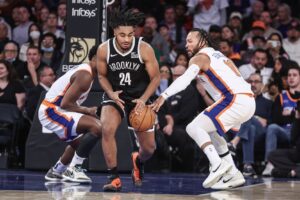In many fantasy basketball drafts, selecting rookies is always done cautiously, and most tend to end up on the waiver wire. However, that can’t necessarily be said for several players in the 2023 draft class. Some rookies have already been solid contributors for managers, while others haven’t had great results. Now that we’re well over a month into the 2023-24 NBA season, it’s worth looking at how some rookies are performing and analyzing their fantasy impact.
Analyzing NBA Rookies’ Early Season Fantasy Basketball Impacts
Victor Wembanyama
It’s safe to say the first overall pick has lived up to the hype so far. Through 18 games, Victor Wembanyama leads all rookies in points, rebounds, steals, and blocks, averaging 19.3 PPG, 9.7 RPG, 1.3 SPG, and 2.7 BPG. His two-way prowess and dominance are in full force each game, and his fantasy impact is immense.
Defensively, his insane length and wingspan make him an efficient disruptor by allowing him to block almost any shot and grab any rebound, and he can even rack up steals. On the other end, he uses his height to his advantage to easily score over defenders. Wembanyama is also showing flashes of playmaking potential and can hit some threes. While his inconsistency and turnovers are downsides, these issues are common among rookies.
Heading into the season, the main concern was Wembanyama’s injury proneness due to his lanky frame. However, he’s only missed one game. Ultimately, his versatility in several categories and potential arguably make him the best fantasy player in his class.
Chet Holmgren
After missing last season due to a foot injury, the 2022 second-overall pick is giving Wembanyama some competition in the Rookie of the Year race. Chet Holmgren averages 17.6 PPG, 8.0 RPG, 0.9 SPG, and 2.2 BPG through 19 games.
Like Wembanyama, the Thunder center’s skinny frame and long wingspan help him thrive on both ends of the floor. Holmgren’s scoring fluctuates, but he can explode for 30+ points. His three-point shooting is especially impressive, hitting 1.7 per game (second-most among rookies) at a 39.5% clip. While he’s had some off shooting nights, he makes his presence felt in multiple other ways, particularly on the defensive end. Holmgren is a skilled shot-blocker who can also contribute some steals while dominating the glass and providing some value in assists. He can do it all.
Brandon Miller
Brandon Miller had an inconsistent start to the season but is poised to take on a greater role with LaMelo Ball injured. The second-overall pick is posting 14.4 PPG, 1.7 3PM, 4.1 RPG, and 0.6 SPG. In some leagues, Miller tended to jump on and off the waivers, but he is worthy of an add with Ball out for an extended period.
At times he’s struggled with shooting consistency, but his spilts are improving as he finds his rhythm. Over the past few games, Miller started to emerge as a three-point threat, converting them at a high rate. He also offers a handful of assists, but he’s a more reliable source of points. The small forward offers little defensively, but he’ll occasionally collect some steals. He’s averaging 1.1 stocks per game, which could increase as the season progresses. However, he can also control the glass, notably on the offensive end.
Scoot Henderson
One of the more disappointing performers is Scoot Henderson. The third-overall pick has struggled to make an impact and so far has offered minimal fantasy value. Especially with the Damian Lillard trade in September, many expected Henderson to take on a significant role for the Portland Trail Blazers. Also, he has already missed several games due to an ankle injury he suffered in early November. While he’s had some promising games after returning, he’s averaging 9.2 PPG, 2.7 RPG, 4.2 APG, and 3.4 TOV on poor efficiency.
His biggest issues are turnovers, shooting, and threes. These struggles were highlighted during his time in the G League and have continued in the NBA. These weaknesses are common with rookies, but they are discouraging for managers. At only 19 years old, Henderson has plenty of time to adjust to the NBA and develop consistency. His roster percentage has dropped significantly, and managers holding him will play the long game. But while he hasn’t had the fantasy impact many have hoped for yet, the potential is there.
Ausar Thompson
Overtime Elite star Ausar Thompson is having an impressive start to the season and is undoubtedly a candidate for ROTY. He was drafted one spot lower than his twin brother Amen Thompson, who has only appeared in four games due to an injury and posted subpar numbers. The Detroit Pistons’ rookie was quickly taken off most waivers as he’s averaging 10.7 PPG, 9.1 RPG, 1.0 SPG, and 1.5 BPG.
The most valuable aspect of Thompson’s game is his defensive prowess. He can easily rack up steals and blocks while also dominating the glass (especially offensively). He doesn’t provide threes or the best shooting splits, but he’s a dominant two-way player. His scoring also fluctuates, but his versatility allows him to contribute to other categories when he struggles in an area. Thompson started all but two games so far, but even with the team’s depth and the return of Bojan Bogdanovic, the 20-year-old should maintain a significant role.
Bilal Coulibaly
Wembanyama’s Metropolitan 92 teammate Bilal Coulibaly also logged some impressive performances in the early season. His minutes are inconsistent, but he’s shown flashes of potential. His offensive game is still coming together, and he’ll look to become a regular scorer with some playmaking ability. Coulibaly’s presence is mainly felt on the defensive end, being an excellent source of stocks. With the Washington Wizards being one of the worst teams in the league, it could present more minutes for the 19-year-old as he develops his game. In 26.3 minutes per game, he’s compiling 8.2 PPG, 3.8 RPG, 1.1 SPG, and 0.7 BPG. He doesn’t have to be rostered but certainly is a player to monitor.
Dereck Lively II
It only took one game for Dereck Lively II to become the Dallas Mavericks’ starting center. His fantasy production tends to fluctuate, especially on the offensive end. Nevertheless, the center is a double-double threat (points and rebounds) and is beginning to show signs of consistency. Lively scored double-digit points six times this season while adding some assists. He is also a stellar shot-blocker and rebounder. While his three-point shot is non-existent, his field goal percentage is excellent at 72.2%. So far, he’s averaging 8.6 PPG, 7.8 RPG, 0.6 SPG, and 1.5 BPG. He’s a solid fantasy player who should be rostered in most leagues.
Jordan Hawkins
14th-overall pick Jordan Hawkins compiled some explosive performances this season for his short-handed team. He’s started nine games and has yet to miss a match, mainly providing points, threes, and rebounds. His value across other categories is limited and his consistency is rough, but he offers a few steals and assists. Hawkins enjoyed increased usage for a stretch, but his minutes will become inconsistent. However, the New Orleans Pelicans are very injury-prone, meaning Hawkins should have more opportunities to play big minutes. He’s been very impressive as a starter, posting some of his best numbers while in the first unit. Hawkins averages 12.9 PPG, 2.7 3PM, 3.8 RPG, and 0.5 SPG; his long-term value is questionable. So, he should just be used as a streamer.
Keyonte George
Since entering the Utah Jazz’s starting lineup in early November, Keyonte George has been on a tear. He’s scored in double figures several times in the first unit, something he only did once when coming off the bench. Moreover, it’s his playmaking that really stands out. His assists aren’t consistent yet, but he’s displayed the potential to be a solid facilitator. George also contributes some threes, along with rebounds and steals on the defensive end. However, his most significant weaknesses are his shooting splits and turnovers. Still, he is a multi-category contributor, averaging 10.5 PPG, 3.3 RPG, 5.0 APG, 1.6 3PM, and 0.5 SPG, as many managers pick him off the waivers.
Jaime Jaquez Jr.
Finally, Jaime Jaquez Jr. became fantasy-relevant about a month ago when the Miami Heat’s injury woes opened up playing time. With an increased workload, the 18th overall pick recorded numerous stellar scoring performances on great efficiency, paired with some assists, rebounds, and a few steals. Jaquez can even knock it down from long range. Even when the Heat return to full strength, their lack of depth should mean more minutes for the rookie, who is averaging 12.0 PPG, 3.9 RPG, 2.6 APG, and 1.1 SPG. With the level Jaquez is playing at, he should be considered as an add.






